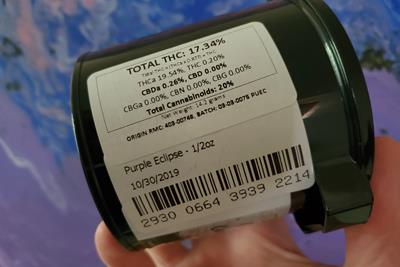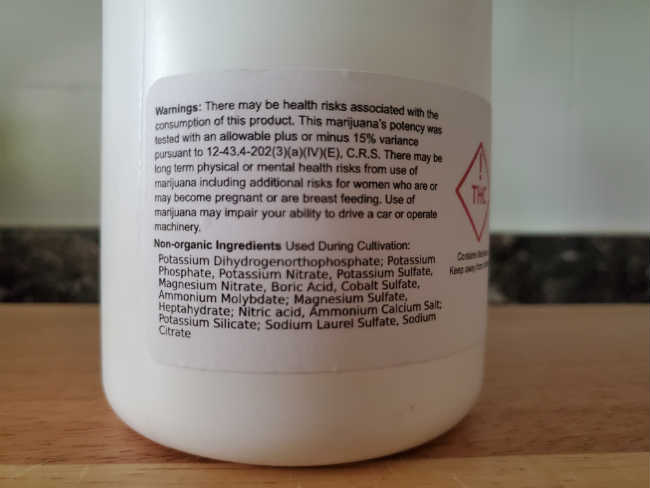
Wednesday June 24, 2020
By Paul Barach
 Education
Education
You’re sitting inside with nothing to do besides smoke some weed. There’s nothing on streaming that interests you, your music playlist is played out, and you can’t imagine picking up that controller one more time. You’re so bored you’ve picked up your container, bottle or bag of weed, turned it around, and started reading the label on the back.
What kind of bizarre foreign language is this? You might be thinking. What are all these weird numbers, letters, and symbols? Even if I understood what I was reading, what possible use is there for most of this information?
After all, you got nearly everything you needed to know from the THC percentage, right? Besides knowing whether it’s an indica, sativa, or hybrid, and maybe the strain’s name, what other information could possibly be necessary when choosing your next bud to enjoy?
Why Reading Your Cannabis Label is Important
It turns out, there’s still a lot of helpful information contained on that cannabis label once you figure out how to read it. Labels and the information they contain can vary from state to state – and country to country – depending on the local cannabis laws and regulations. However, there’s some information that’s pretty commonly displayed on legal cannabis products no matter where you are.
Being able to decipher these labels will make you a more informed cannabis consumer, and can help you dial in the right strain for the experience you’re hoping to have once you light it up. So let’s dive into what you may be reading on your cannabis label.
Δ9THC, THCA, Total THC
Whether the label lists the Δ(Delta)-9THC, Δ9THCA, THCA, or THC, all you need to be looking for is the Total THC, which tells you what percentage of the flower is that main molecule that gets you stoned. (The Delta symbol is just a fancier way of saying THC.)

Why all the extra acronyms? The THC percentage listed on the label is the small amount of THCA contained in the plant that has already degraded and become activated. The larger percentage of THCA tells you the amount of THC contained in the plant that remains deactivated and thus stable. As long as the acid chain – the A in THCA – remains attached to the molecule it will have little to no effect on your body. This is why eating cannabis plant by itself doesn’t get you high. Once you apply some heat via flame, hot metal, or stovetop, the THCA molecule becomes decarboxylated and therefore activated. The small percentage of activated THC may burn off when you apply the flame, making the THCA number all the more important, since that’s going to be mostly what is intoxicating you. A higher THCA percentage also usually means a fresher bud.
CBD and CBDA
Similar with THC and THCA, CBDA is the inactive form of the CBD molecule. CBD is known to reduce stress and anxiety, as well as work as an anti-inflammatory. It can also relax muscles and lessen pain. If you’re looking for a less psychoactive strain of cannabis or a mellower one, you’ll want to find one with a high CBD percentage.
CBN
This molecule has been linked to increasing appetite and decreasing inflammation. It’s also been shown to have possible sedating effects when paired with THC. If you need a good night’s rest, look for a high CBN percentage on the label.
Because each cannabinoid has its own specific medical benefit, the more diverse a strain’s cannabinoid content, the more health benefits the strain may have.
Terpenes
If the label lists specific terpenes, you’re getting some solid information on both the dominant flavors of your weed as well as the potential effects. Terpenes are the essential oils produced by the cannabis flower. They are what makes one strain smell like a pine forest, another smell like a pineapple orchard, and a third smell like a potpourri basket.
However, these terpenes are also linked to cannabis’ effects thanks to what is known as the entourage effect. A strain high in pinene won’t just smell like evergreen needles, but may also help to reduce anxiety and relieve pain. A spicy, lavender smelling bud high in linalool can fight depression, and a citrusy, lemony strain bursting with limonene can elevate your mood.
So, if you see these terpenes listed, it gives you a good preview for what you’re in for and can help you make choices on what strain to buy.
Pesticides and Non-Organic Ingredients
Humans are not the only creatures that enjoy cannabis. While most pot consumers are down to share their stash with any animals that would seek to partake (like if an eagle swooped down or something), there are some bugs, molds, and mildews that can harm the plant.

Some growers use pesticides to protect their plants from these bugs, which can also be harmful to humans in high amounts. If you want to avoid certain chemicals from entering your body, it’s best to read the pesticides portion on the label.
Laboratory Tested
You’ll always want bud that’s been lab tested, since that means that it’s been scanned for pesticides. The information on the label should l tell you which lab performed the test and when, as well as when those lab tests expire. Some labels will tell you what pesticides were used, while others will list how much pesticide residue was found in the bud. The majority will simply tell you whether or not the product has passed the lab test, which means their pesticide levels were under 0.1 parts per million (PPM).
Produced By/Processed By
This tells you which farm or grower produced the cannabis you’ll be consuming, as well as which company did the curing and trimming. While it may seem a little “in the weeds” to know all this detail, if you find a strain you really enjoy, you can look for that grower by name. They probably have plenty of other strains that you’ll like as well.
Packaging/Expiry Dates
Some cannabis labels will list the date that the cannabis was packaged. Bear in mind that this date tells you when the finished product was sealed in its packaging, not when the flower was harvested.
Expiry dates will tell you when the plant will begin to lose its potency as cannabinoids and terpenes begin to degrade. The weed won’t make you sick if you smoke it past the expiry date, but the flower may not be as potent and the effects could be less enjoyable.
Warnings/Disclaimers
These are federally or state-mandated warnings that the product you’re about to consume is intoxicating and shouldn’t be used by anyone underage or about to do something that requires a lot of focus, like operating heavy machinery. Warnings like this are pretty much standard on cannabis products and are meant to help consumers stay safe and avoid any issues.
So, the next time you’re at a dispensary, be sure to flip over your weed before your purchase and take a glance over the label. It will make you a more informed consumer and help you have the best experience possible. Feel free to add comments or ask questions below!







